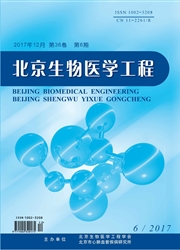

 中文摘要:
中文摘要:
目的:通过图像融合方法结合解剖和功能医学图像以提供更多有用的信息并辅助医生诊断。方法利用稀疏表示能很好地反映图像特征的优势。首先,选取医院脑梗死和脑出血的CT和MRI的临床图像,采用双稀疏字典算法得到稀疏字典,再通过结合空间域信息的最大选择法作为融合规则对其进行融合,并与基于主成分分析( principal component analysis , PCA)和离散小波变换( discrete wavelet transform, DWT)方法的图像融合结果在主观方面以及客观方面的QAB/F和Piella指标上进行比较。结果本文提出的方法所获得的融合图像主观评价优于另外两种方法。 QAB/F和Piella的均值分别为0.9139和0.7213,客观评价指标也优于另外两种方法。结论基于双稀疏字典的图像融合算法得到的融合图像更清晰,对比度更高,并且特征保留效果更好,有助于医生的诊断。
 英文摘要:
英文摘要:
Objective We use the method of image fusion combining anatomical and functional medical images to provide more useful information and to help the doctors in diagnosis .Methods Sparse representation can reflect the advantage of the image feature well .First, the CT and MRI images of cerebral infarction and cerebral hemorrhage from the hospital are selected , and the algorithm based on double sparse dictionary is used to obtain the sparse dictionary .Then the method of max selection with information of spatial domain as the fusion rule fuses the selected clinical images .Finally, the results of the proposed method are compared with the results of PCA method and DWT method in the subjective aspect and the objective aspect on the indices of QAB/F and Piella.Results Subjective evaluations of the fusion images obtained from the proposed method are better than the other two methods , and the mean values of QAB/F and Piella in the objective aspect are 0.9139 and 0.7213, which are superior to the other two methods .Conclusions The fusion images obtained from the proposed method based on sparse dictionary are clearer , with higher contrast , and have more features of source images , which is helpful in diagnosis .
 同期刊论文项目
同期刊论文项目
 同项目期刊论文
同项目期刊论文
 Improved particle filtering based algorithm for time delay and symbols joint estimation of PSK signa
Improved particle filtering based algorithm for time delay and symbols joint estimation of PSK signa A novel joint parameter estimation method based on fractional ambiguity function in bistatic multipl
A novel joint parameter estimation method based on fractional ambiguity function in bistatic multipl Fractional Time Delay Estimation Algorithm Based on the Maximum Correntropy Criterion and the Lagran
Fractional Time Delay Estimation Algorithm Based on the Maximum Correntropy Criterion and the Lagran Parameter estimation based on fractional lower order statistics and fractional correlation in wideba
Parameter estimation based on fractional lower order statistics and fractional correlation in wideba 期刊信息
期刊信息
